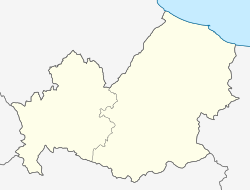Portocannone
Portkanuni | |
|---|---|
| Comune di Portocannone | |
| Coordinates: 41°54′53″N 15°00′29″E / 41.91472°N 15.00806°E | |
| Country | Italy |
| Region | Molise |
| Province | Campobasso (CB) |
| Government | |
| • Mayor | Giuseppe Caporicci |
| Area | |
| • Total | 13.11 km2 (5.06 sq mi) |
| Elevation | 148 m (486 ft) |
| Population (30 November 2017)[2] | |
| • Total | 2,488 |
| • Density | 190/km2 (490/sq mi) |
| Demonym | Portocannonesi |
| Time zone | UTC+1 (CET) |
| • Summer (DST) | UTC+2 (CEST) |
| Postal code | 86045 |
| Dialing code | 0875 |
| Website | Official website |
Portocannone (Arbërisht: Portkanuni) (gate of the law) is an Arbëreshë comune in the Province of Campobasso, in the Italian region Molise, located about 50 kilometres (31 mi) northeast of Campobasso.
Transportation[edit]
Portocannone was served by a railway station, the Guglionesi-Portocannone railway station.on the Termoli-Campobasso and Termoli–Venafro line, but the station has been closed for a few years and does not have passenger service.
People[edit]
The grand-father of Mateo Musacchio was born in this City.[3]
References[edit]
- ^ "Superficie di Comuni Province e Regioni italiane al 9 ottobre 2011". Italian National Institute of Statistics. Retrieved 16 March 2019.
- ^ All demographics and other statistics: Italian statistical institute Istat.
- ^ "Calciomercato Roma, Musacchio è il primo rinforzo". RomaToday. Retrieved 2018-03-22.




Well, that’s interesting to know that Psilotum nudum are known as whisk ferns. Psilotum nudum is the commoner species of the two. While the P. flaccidum is a rare species and is found in the tropical islands. Both the species are usually epiphytic in habit and grow upon tree ferns. These species may also be terrestrial and grow in humus or in the crevices of the rocks.
View the detailed Guide of Psilotum nudum: Detailed Study Of Psilotum Nudum (Whisk Fern), Classification, Anatomy, Reproduction